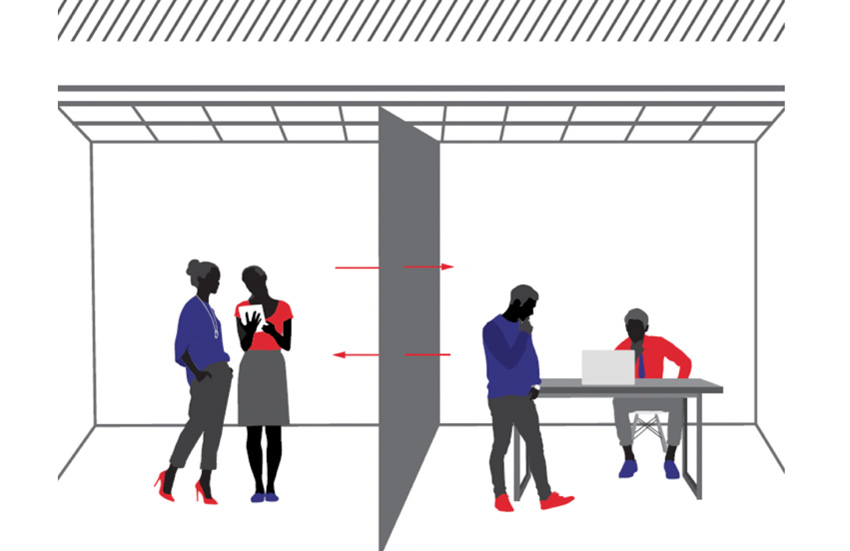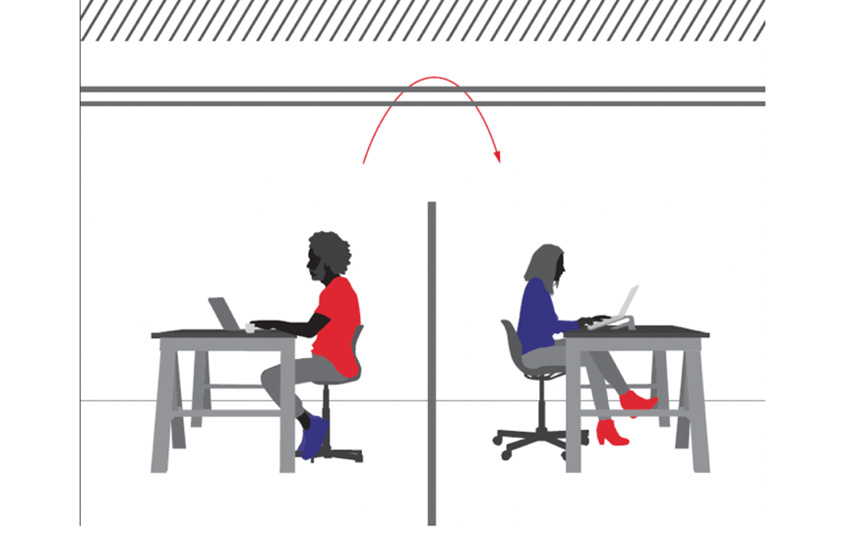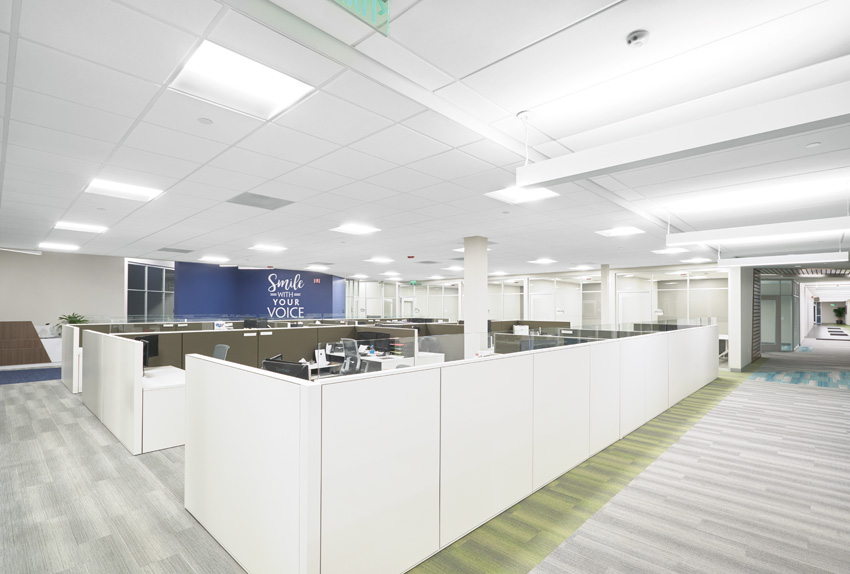Putting People First
Acoustical Performance Measurements for Speech Privacy
There are a number of important sound measurements used to rate acoustic performance, and many of them work together to help specifiers provide the best acoustic system for a space. This section reviews the importance of balanced acoustical design for occupant well-being and defines various acoustical performance measurements.
Noise Reduction Coefficient (NRC)
NRC is used to measure how well a surface can absorb sound from all angles. NRC is expressed as a decimal between 0.00 (e.g., a concrete floor) and 1.00 (e.g., a high-sound-absorbing product), and it indicates the average percentage of four frequencies—250, 500, 1,000, and 2,000 Hz—that the surface absorbs. A higher number indicates a higher level of sound absorption.

Noise reduction coefficient (NRC) measures how well a surface can absorb sound from all angles.
Sound Transmission Class (STC)
Sound transmission class (STC) is a measure for rating sound isolation of a building wall assembly. That is, it measures how well a wall partition can block sound from one room to the next. For example, a sound that starts as 100 dB in one room may be transmitted through a wall and received at half that amount. STC rating is associated with a wall assembly’s ability to isolate sound; a higher STC is better. As a general guide, an STC value of 35 is considered to be low performance, and a value of 55 or higher is considered to be high performance. For spaces with framed wall assemblies, STC performance can be increased by adding insulation.
For new construction, the current International Building Code (IBC) requires lab-tested STC 50 for walls, floors, and ceilings. A higher STC of 55 to 60 will ensure optimal soundproofing, but for spaces where speech privacy is a concern, a minimum of STC 50 is ideal.

Sound transmission class (STC) is a measure for rating the performance of a wall system as a barrier to airborne sound between adjacent closed spaces.
CAC is a measure for rating a ceiling system’s performance as a barrier to airborne sound transmission through a common plenum between adjacent closed spaces such as offices, conference rooms, health-care examination rooms, or classrooms, as well as between those spaces and areas, such as corridors and hallways.
A higher CAC rating is associated with high sound blocking, which is ideal for spaces needing speech privacy and confidentiality. For example, a ceiling system that has a CAC less than 25 is considered to be low performance, where a ceiling with a CAC of 35 or greater is considered to be high performance. Ceiling systems that have a CAC 45+ provide the highest levels of confidentiality, taking speech privacy to the next level.

Ceiling attenuation class (CAC) is a measure for rating a ceiling system’s performance as a barrier to airborne sound transmission through a common plenum between adjacent closed spaces.
Speech Privacy Potential (SPP)
Speech privacy potential (SPP) is a metric designed to determine the speech privacy between two adjacent spaces. The two factors that need to be considered to determine the SPP are the background sound level in the receiving space, which is expressed as noise isolation class (NIC), and the acoustic separation of the total construction between the spaces, expressed as STC. These two ratings, when combined, provide a strong indicator of the degree of speech privacy. (STC + NIC = SPP.)
In practice, determining the SPP can be more challenging than a simple calculation, mainly because background noises can shift the number to enable higher levels of privacy. For example, if a receiving space has an NIC rating of 0—or almost no background noise—and the wall in between is rated with an STC value of 55, the SPP will be 55, which is considered quite low (see Privacy Class sidebar). However, if a low background noise level is added, for instance NIC 25, the total SPP ends up at 80, which is considered to be quite high. Bump the background noise up a little bit more, and the SPP can easily reach confidential levels.
For most workplaces, the best practice is to combine acoustical partitions with a moderate STC level, and adjust background noise levels to achieve the desired SPP level. The problem, as noted earlier, is that wall partitions in open spaces such as cubicles tend to have much lower STC values because they do not extend to (or through) the ceiling panels. So, a cubicle partition may have a low STC value, such as 35. Even a background noise level of NIC 30 will mean that the SPP is still quite low.
Noise Isolation Class (NIC)
NIC is a standard (ASTM E336) field-measured performance of sound isolation between adjacent closed spaces. It is commonly referred to as a “field test” because it tested on-site in a building, rather than in a laboratory. NIC refers to the degree of sound control between two adjoining areas measured at various frequency levels and is represented as a single number. The higher the number, the better the control. Because the test is conducted on-site, NIC tests aim to consider the noise in the entire environment, including ceiling CAC/NRC, flooring, flanking (doors, windows, penetrations), wall STC, and furniture, not just the wall or surface being tested.
The ABCs of Balanced Acoustical Design
As noted earlier, the main concern with speech privacy is that voices can both be heard and understood between spaces. This aspect of speech being intelligible between walls is important, both in terms of the required STC level but also with a higher CAC level to reduce sound transfer through a shared ceiling plenum.
The concept of balanced acoustical design is known to be very effective in achieving speech privacy in interior spaces such as offices, schools and health-care facilities where spaces share a common ceiling plenum. To work, the design must perform three key functions. It must:
- absorb the sound;
- block sound transmission between adjacent spaces; and
- cover any remaining sound.
These “ABCs of balanced acoustical design” must all be included, and they must work together. Sound can be absorbed with high-performance acoustical ceiling and wall panels that stop sound from reflecting or being heard in adjacent spaces. High-performance ceilings and a combination of wall partitions and furniture panel designs and layout can block sound. If there is any remaining sound that compromises speech privacy, an adjustable sound-masking system can be used to cover and evenly distribute electronic sound that meets the desired privacy class.
Balanced acoustical design can greatly improve speech privacy in a building and help a medical space comply with HIPAA requirements. One of the more common reasons for a lack of speech privacy is that while a wall may provide adequate sound control through an acceptable STC level, the plenum—the space between the ceiling and the concrete deck of the building—may have a lower CAC rating than necessary to block the sound. For example, if a wall has an STC of 44 but the ceiling system has a low CAC, sounds will still transfer between the spaces.
Ceiling panels with higher CAC ratings can be installed to lessen the sound transfer and achieve confidential speech privacy for the space.
Speech Privacy in Practice: How Ceilings Can Help Create Balanced Acoustical Design
As discussed in the previous section, the concept of balanced acoustical design requires that the “ABCs” (absorb, block, and cover) are included and work together in the space. This section provides an overview of how balanced acoustical design can be achieved through high-performance acoustical ceiling panels to improve the overall comfort and well-being of occupants in those spaces.
Office Environments
As a recap, some of the key acoustical challenges in office environments stem from inadequate or unbalanced acoustical performance in both open- and closed-plan spaces. Open office environments, for example, may include cubicles in place of permanent partitions. Cubicles tend to be three sided with low wall heights, and sound easily transfers between the partitions. Following are techniques for solving some of the problems with open environments.
- Aim for balanced acoustical performance, with acoustical ceilings that have an NRC of at least 0.75, and ensure that the partition wall STC matches that level.
- Attach light fixtures in positions where they will not reflect sound into the adjacent cubicle (e.g., not above a partition).
- Ensure that noisy office machinery and copy machines are located far away from the cubicles.

Open office environments can get noisy. But with balanced acoustical design, ceiling panels with high sound absorption and sound blocking can create better spaces.
Private offices present different acoustical challenges. While the spaces themselves may be enclosed, sound can still travel over the partition walls and through the suspended acoustical ceiling. If this happens, speech privacy and confidentiality can be compromised. There are several ways to solve this problem and improve the speech privacy between the spaces as follows.
- Extend the walls from the floor to the structural deck.
- Ensure the STC value of the wall matches the ceiling panel CAC value.
- Specify ceiling tiles with a minimum CAC of 35.
- Seal penetrations in the ceiling, such as light fixtures, diffusers, and sprinklers.









